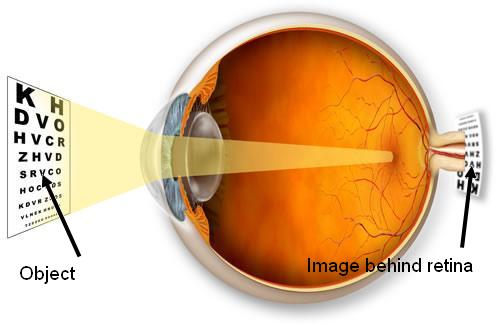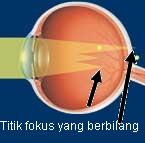Introduction
The human eye works in a manner very similar to that of a camera. In order to see clearly, objects that we are looking at must be properly focused on the retina. This is acheived through the convergent power of the cornea and lens. When images are not properly focused on the retina, a refractive error exists. This condition typically produces blurry vision which improves with the use of eyeglasses or contact lenses.
There are three basic types of refractive errors:
1. Myopia (Near sightedness)
Images are focused in front of the retina

Diagram showing image in myopic eye
2. Hyperopia (Far sightedness)
mages are focused behind the retina.

Diagram showing image in hyperopic eye
3. Astigmatisma
Images have more than one focal point.

Diagram showing image in astigmatic eye
Signs & symptoms
|
: | Poor distance vision with good near vision. |
|
: | Better distance vision than near vision. Fatigue when uncorrected. |
|
: | Images have more than one focal point. |
Images viewed by people with refractive error :
Myopia

Hyperopis

Astigmatism

Complications
Uncorrected refractive error in adult will cause eye discomfort, tiredness, and sometime headache to those individuals with refractive error.
Caution! children with refractive error need special attention and proper eye care consultation. Untreated refractive error in children may lead to ambyopia (lazy eye).
Treatment
There are few treatment options for myopia, hyperopia and astigmatism.
Non-surgical treatment options include:
- Wearing of glasses
- Wearing of contact lenses
Surgical treatment (refractive surgery) options include:
- laser procedures (LASIK, ReLex SMILE, PRK, ALK, ReLex etc)
- clear lens extraction, replacing clear natural lens with artificial lenses, implanted in the eyeball.
While there are numerous surgical options available, not all individuals are good candidates for specific procedures. Patients should review these options in depth with their doctors prior to making any final decisions and treatment.
Prevention
Children are advised to avoid these activities:
- Prolong reading,
- Watching television at near distance,
- Facing computer monitor for long duration,
- Reading in places with poor lighting
Above activities will increase risk of inducing myopia or making existing myopia to get worse.
Other Relevant Condition
Presbyopia affects people as they enter their 40s. This is caused by changes within the eye’s crystalline lens as one ages, reducing the lens ability to focus to near object. Presbyopia affects everyone, and eventually everyone will need to wear reading glasses, bifocals or multifocal. Currently, presbyopia can be corrected by refractive surgery (LASIK).
| Last Reviewed | : | 23 August 2019 |
| Writer | : | Dr. Joseph Vijaya Alagaratnam |
| Reviewer | : | Dr. Rosniza bt. Ab. Razak |







